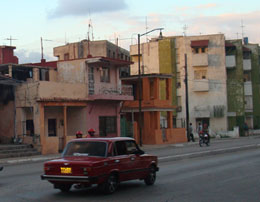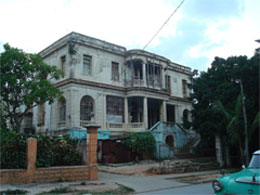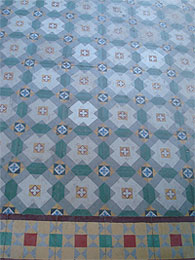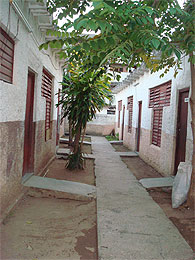Old School
He was aloof, my taxi driver. I’d negotiated with him before we left, ¿cuánto va a costar?? to go to an address that wasn’t exactly specific – someplace near the corner of two numbered streets, somewhere in the district called Marianao, the address that my mother had given me after writing to an old friend who would remember it, of her school when she was growing up in Cuba. He seemed bothered by my task: that I wasn’t sure exactly where I was going, that I’d be needing him to wait.
I’d had so many nice cabbies – highly spirited drivers who gabbed away during the drive from our hotel to the city center, pointing out landmarks or making jokes about passing through a time machine to be in their country. But this guy was dour, humorless. Instead of making small talk, I stared out the window, scanning the rows of faded pastel houses and dusty buildings. I hoped we would be able to find the school, and wondered if it still was a school, if it even existed anymore.

We took another route. Not the high road, the habitual drive along the big avenue by the ocean and into the old quarter of the city that we so often followed, but the low road, plunging into the grid of streets of a part of the city most taxi drivers assumed we did not want to see. At the designated crossroads, I asked the driver to wait. He agreed by a grunt, and I got out to hunt for the hallowed building that might be a school. I aimed my camera at a small square stone on the corner of the crumbling sidewalk, registering the intersection where I stood, to use as a marker later when I would review the photographs.
A man on the street watched me, with curiosity, as I snapped pictures of the sidewalk. He wore a careful smile and a pressed plaid shirt. He didn’t look like he was on the make, so I took the risk, in my simple Spanish, to ask him if he knew where to find the Colegio Buenavista.
He surveyed the corner to get his bearings. He pointed his long brown finger up the street. He told me he knew where it was because his brother had gone to that school, long ago. I decided to tell him that it was also the escuela de mi madre. I made a waving hand motion to the side of my head – it might be the universal signal for “a long time ago” – a visual to reinforce that I was speaking of many decades in the past. I asked him to describe the school to my taxi driver, and hoped the transmission from one local to another would be more efficient. He agreed and followed me to the car, a beat-up squared vehicle that reeked of gasoline. I heard him describe the building, and its placement further up the street. My driver shrugged his shoulders, agreeing to take me there but with a complete absence of enthusiasm.

A few blocks later, the driver stopped the car and pointed. I stepped out of the cab before a grand edifice, colonial and ornate with a stately gate. The building looked like what an old school should look like, with a symmetrical stairway like dignified crossed arms in the front of the building, a grand gaping balcony on the second floor smiling down. The paint was fatigued and chipped, but at one time would have been a brilliant turquoise blue. It looked like a sad, old, aristocratic lady, dressed in her worn, out-of-fashion finery just to walk around the block, elegant in a faded, nostalgic way.
I climbed the staircase. At the landing on the second floor, and old couple sat in unmatched chairs. I meekly greeted them, not wanting to impose, but oh so curious to even peek inside. I explained my pilgrimage, and they responded in rapid-fire Spanish in what was clearly affirmative. “Despacio, slowly,” I begged. Yes, it was the school, though now it was divided into apartments. But it had been the Colegio Buenavista, along with the building just beside it, which remains a school to this day.

They opened a door, motioning for me to go in. I entered a wide school-like hallway with a vaulted ceiling, painted nearly the same blue as the building’s exterior. The colors of the tiled-floor were slightly dulled by time, but otherwise in perfect condition. Looking down a stairwell that was once filled with young students scrambling up the stairs, I saw someone’s laundry hanging in a ventilation passage. The faint smell of garlic taunted from the back of the building.
I pictured my mother standing in this hallway, holding her books, laughing with her classmates. I imagined the rushing about of young uniformed schoolgirls, and her among them. I thought about Short-pants and Buddy-roo, and how they disappear each day into the private mystery of their at-school lives, coming into their own, just as my mother made her way here, in this very place, years ago.
They suggested I visit the building next door. After lots of nodding and smiling and many muchas gracias, I made my way to the driver and motioned where I was going. There, a concierge of sorts listened to my explanation without compassion. The man I’d seen earlier – in the plaid shirt, the one who’d directed me here – appeared on the sidewalk behind me. No doubt his curiosity had kicked in, so he’d turned up to see what was unfolding. With his intervention, the woman cautiously opened the door for me. It was late afternoon and school had let out, but a few children remained and the women there – teachers, cleaners, administrators, helpers – gathered around me. Once they heard I had come from France, another woman appeared, a French teacher, and we were able to converse with full comprehension. Yes,  this had been the Colegio Buenavista. Now it operates under a different name and is a state-run school. Another woman appeared and offered to escort me around the school, a one-story building laid out like a motel, with a wide open courtyard between the long rows of doors and the covered walkway. Aqui, she pointed down an alley on the side, these were the main classrooms.
this had been the Colegio Buenavista. Now it operates under a different name and is a state-run school. Another woman appeared and offered to escort me around the school, a one-story building laid out like a motel, with a wide open courtyard between the long rows of doors and the covered walkway. Aqui, she pointed down an alley on the side, these were the main classrooms.
I lingered as long as I could, in broken Spanish and in better French conversing with them about the school and its students. Mindful of my waiting driver and also wanting my local visits to be discreet – for my own safety as well as theirs – I thanked them all and left, even though I wanted to stay. You can come back tomorrow, they told me, when school is in session. Yes, maybe I will, I’d said. I wanted to, really.
In the taxi I turned and watched out the rear window as the two buildings shrunk from view. I didn’t expect it to be emotional, making this little side trip to visit my mother’s old school. I saw it as a quick errand, just going to visit an old building so I could surprise her with a few photos of her past. Not until I was standing in these buildings did I feel the sense of a history – not just a general history of a place from another era, but a specific touch point in the history of someone so near to me. I didn’t expect to be so moved. I didn’t expect to be overwhelmed. I didn’t expect my eyes to fill up with such wet, heavy tears.
“Hotel?” the taxi driver asked. His dark eyes in the rear view mirror softened when he saw that I was crying. By now my mouth was surely a grimace, the one that accompanies tears we try to withhold. He turned to look at me directly. He smiled, and then, in his broken English, “Where you want to go?”
Home is what I wanted to say. Home, now and fast to my mother and to her arms and her stories. Home to her to hear everything I possibly can hear while she’s still here to tell it. Home to appreciate who she was and who she became. That’s what I wanted to say. Instead I said, “Sí, to my hotel.”


November 23rd, 2009 at 8:56 am
I had been waiting for this post… it is so moving, thank you for this morning emotion.
November 23rd, 2009 at 11:05 am
Wow this was beautiful. I was in tears before you. The pictures are great. Thanks, I enjoyed the taxi ride and visit!
November 23rd, 2009 at 2:24 pm
It reminds me of my grand mother, whom I wanted to interview about her past, and never agreed.
It reminds me of my own mother and father, and a “book” I wrote when I was young called “grâce à un cousin”, about how my mum and dad met (thanks to a cousin). I definitively want to collect those precious things. It is so great you had the opportunity to do that.
Some tears are good tears…
November 23rd, 2009 at 3:06 pm
Even before you arrived in Cuba, these writings brought back so many memories of your Grandparents. I still have the picture of your Mom and her sisters sitting on a wall in front of their Cuban home, I’m making a call today to have our step-Dad do a video of highlights of his life for his children (including us) and grandchildren. I met this fellow at a party who
does this and I am so sorry to not have one of other family members who are gone. Happy Thanksgiving to all! hugs, Betty
November 23rd, 2009 at 3:45 pm
I’m so glad you took this journey as now I have a visual of something from my mother’s past as well. Thank you.
November 23rd, 2009 at 4:01 pm
Yep, got me too. Isn’t it funny how something as inanimate as a building can bring up so much emotion, even when your memories aren’t from the building.
November 23rd, 2009 at 7:17 pm
Beautiful post. Has your mama seen the photos? (And I love the tile floor…)
November 23rd, 2009 at 8:23 pm
What joy for you! My gram spent a year in Cuba before entering the US, after leaving Russia. All she would ever say is “how very hot it was, compared to Russia”. Makes me wonder what she couldn’t say.
November 23rd, 2009 at 9:43 pm
Thank you for refreshing my memory. I’m so glad you were able to visit where your mom and I went to school. The teachers were strict but not mean. I remember your mom & I taking the trolley car near our home to go to Colegio Buenavista. We used to place the metal caps from soda bottles on the tracks and watch the trolley car flatten them.
November 24th, 2009 at 12:03 pm
I wept too.
November 24th, 2009 at 2:56 pm
What a gift you have given us all!
November 25th, 2009 at 1:04 am
Those tears…we can all use them. Your writing is getting more and more powerful! I want to go home to my mom, right now. Thanks for this!
December 8th, 2009 at 11:59 am
What an emotional experience! Something similar happened to me a few years ago – taking my mother to an army base in Alabama where she and my dad had been stationed during WW2. She remembered every building, their apartment, downtown, the surrounding countryside…Her eyes teared up and so did mine!
April 17th, 2010 at 5:12 am
your story made me cry. i too was a student of buenavista . I have been trying to find something on internet about the school like pictures or memory books but have found nothing.
thanks for the story